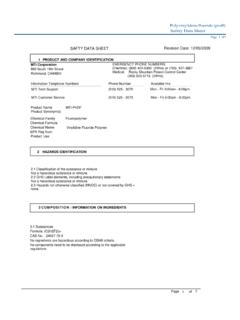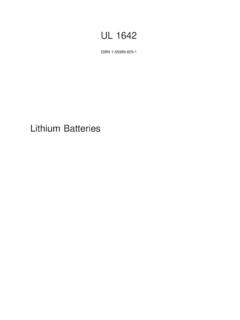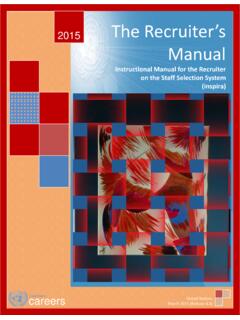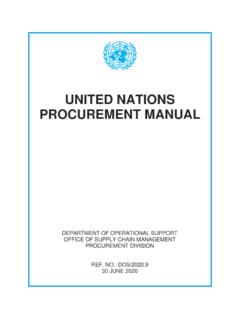Transcription of UN Manual of Tests and Criteria - mtixtl.com
1 UN Manual of Tests and Criteria 4th Revised Edition Lithium Battery Testing Requirements - 394 - Lithium batteries Purpose This section presents the procedures to be followed for the classification of lithium cells and batteries (see UN Nos. 3090 and 3091, and the applicable special provisions of Chapter of the Model Regulations). Scope Lithium cells and batteries shall be subjected to the Tests , as required by special provisions 188 and 230 of Chapter of the Model Regulations prior to the transport of a particular cell or battery type. Lithium cells or batteries which differ from a tested type by: (a) a change of more than g or 20% by mass, whichever is greater, to the cathode, to the anode, or to the electrolyte; or (b) a change that would materially affect the test results, shall be considered a new type and shall be subjected to the required Tests .
2 In the event that a lithium cell or battery type does not meet one or more of the test requirements, steps shall be taken to correct the deficiency or deficiencies that caused the failure before such cell or battery type is retested. For the purposes of classification, the following definitions apply: Aggregate lithium content means the sum of the grams of lithium content or lithium equivalent content contained by the cells comprising a battery. Battery means one or more cells which are electrically connected together by permanent means, including case, terminals, and markings. NOTE: Units that are commonly referred to as "battery packs" having the primary function of providing a source of power to another piece of equipment are for purposes of these Regulations treated as batteries.
3 Button cell or battery means a round small cell or battery when the overall height is less than the diameter. Cell means a single encased electrochemical unit (one positive and one negative electrode) which exhibits a voltage differential across its two terminals. Under these Regulations, to the extent the encased electrochemical unit meets the definition of "cell" herein, it is a "cell", not a "battery", regardless of whether the unit is termed a "battery" or a "single cell battery" outside of these Regulations. Component cell means a cell contained in a battery. Cycle means one sequence of fully charging and fully discharging a rechargeable cell or battery. Disassembly means a vent or rupture where solid matter from any part of a cell or battery penetrates a wire mesh screen (annealed aluminium wire with a diameter of mm and grid density of 6 to 7 wires per cm) placed 25 cm away from the cell or battery.
4 Effluent means a liquid or gas released when a cell or battery vents or leaks. Equivalent lithium content is defined in the definition of lithium content. First cycle means the initial cycle following completion of all manufacturing processes. - 395 - Fully charged means a rechargeable cell or battery which has been electrically charged to its design rated capacity. Fully discharged means either: a primary cell or battery which has been electrically discharged to remove 100% of its rated capacity; or a rechargeable cell or battery which has been electrically discharged to its endpoint voltage as specified by the manufacturer. Large battery means a battery in which the aggregate lithium content of all anodes, when fully charged, is more than 500 g.
5 Large cell means a cell in which the lithium content or lithium equivalent content of the anode, when fully charged, is more than 12 g. Leakage means the escape of material from a cell or battery. Lithium content is applied to lithium metal and lithium alloy cells and batteries, and for a cell means the mass of lithium in the anode of a lithium metal or lithium alloy cell, which for a primary cell is measured when the cell is in an undischarged state and for a rechargeable cell is measured when the cell is fully charged. The lithium content of a battery equals the sum of the grams of lithium content contained in the component cells of the battery. Lithium-equivalent content is applied to lithium-ion cells and batteries, and for a cell is measured as times the rated capacity of the cell in ampere-hours, with the result expressed in grams.
6 The lithium- equivalent content of a battery equals the sum of the grams of lithium-equivalent content contained in the component cells of the battery. Lithium-ion cell or battery means a rechargeable electrochemical cell or battery in which the positive and negative electrodes are both intercalation compounds (intercalated lithium exists in an ionic or quasi-atomic form with the lattice of the electrode material) constructed with no metallic lithium in either electrode. A lithium polymer cell or battery that uses lithium-ion chemistries, as described herein, is regulated as a lithium-ion cell or battery. Mass loss means a loss of mass that exceeds the values in table 1 below.
7 In order to quantify the mass loss, the following procedure is provided: ()100 MMM (%) loss Mass121 = where M1 is the mass before the test and M2 is the mass after the test. When mass loss does not exceed the values in table 1, it shall be considered as "no mass loss". Table 1: Mass loss limit Mass M of cell or battery Mass loss limit M < 1 g % 1 g< M < 5g % M 5 g % Primary means a cell or battery which is not designed to be electrically charged or recharged. - 396 - Prismatic cell or battery means a cell or battery whose ends are similar, equal and parallel rectilinear figures, and whose sides are parallelograms. Protective devices means devices such as fuses, diodes and current limiters which interrupt the current flow, block the current flow in one direction or limit the current flow in an electrical circuit.
8 Rated capacity means the capacity, in ampere-hours, of a cell or battery as measured by subjecting it to a load, temperature and voltage cut-off point specified by the manufacturer. Rechargeable means a cell or battery which is designed to be electrically recharged. Rupture means the mechanical failure of a cell container or battery case induced by an internal or external cause, resulting in exposure or spillage but not ejection of solid materials. Short circuit means a direct connection between positive and negative terminals of a cell or battery that provides a virtual zero resistance path for current flow. Small battery means a battery composed of small cells, and in which the aggregate lithium content of all cell anodes, when fully charged, is not more than 500 g.
9 Small cell means a cell in which the lithium content of the anode, when fully charged, is not more than 12 g. Type means a particular electrochemical system and physical design of cells or batteries. Undischarged means a primary cell or battery that has not been wholly or partly discharged. Venting means the release of excessive internal pressure from a cell or battery in a manner intended by design to preclude rupture or disassembly. When a cell or battery type is to be tested under this sub-section, the number and condition of cells and batteries of each type to be tested are as follows: (a) When testing primary cells and batteries under Tests 1 to 5 the following shall be tested: (i) ten cells in undischarged states, (ii) ten cells in fully discharged states, (iii) four batteries in undischarged states, and (iv) four batteries in fully discharged states.
10 (b) When testing rechargeable cells and batteries under Tests 1 to 5 the following shall be tested: (i) ten cells, at first cycle, in fully charged states, (ii) ten cells, at first cycle, in fully discharged states, (iii) four batteries, at first cycle, in fully charged states, (iv) four batteries, at first cycle, in fully discharged states, (v) four batteries after fifty cycles ending in fully charged states, and (vi) four batteries after fifty cycles ending in fully discharged states. - 397 - (c) When testing primary and rechargeable cells under test 6, the following shall be tested: (i) for primary cells, five cells in undischarged states and five cells in fully discharged states, (ii) for component cells of primary batteries, five cells in undischarged states and five cells in fully discharged states, (iii) for rechargeable cells, five cells at first cycle at 50% of the design rated capacity and five cells after 50 cycles ending in fully discharged states, and (iv) for component cells of rechargeable batteries, five cells at first cycle at 50% of the design rated capacity and five cells after 50 cycles ending in fully discharged states.















